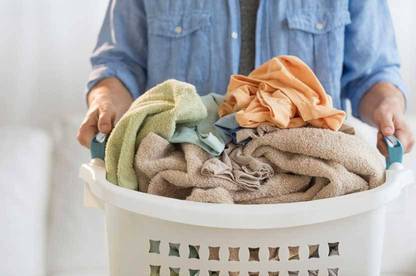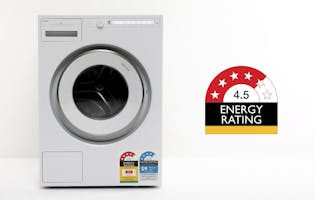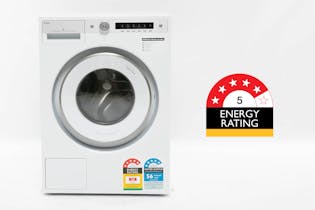How to buy a washing machine
Find the best washing machines for your home with our buying guide and washing machine reviews for 56 current and 122 discontinued models.
We’ve tested the dirt removal, gentleness and efficiency of both top loader and front loader washing machines.
Types of washing machines
There are two main types of washing machine – top loaders and front loaders. Another option is a combination washing machine and dryer.
Top loading washing machines

Top loader washing machines usually get clothes clean by vigorously swirling them back and forth in the water. They’re faster than front loaders but can be tougher on your clothes.
If you just need a washing machine to get the dirt out of non-delicate clothes and fabrics, any of the top loaders in our test will do a good job.
Impeller or agitator top loading washing machines?
Top loading washing machines have 2 options for swirling the load: an agitator (central spindle), or an impeller (a small bump at the bottom of the bowl). Impellers spin and pulse to turn the washing over, rather than twisting it. Washing machines with impellers tend to be easier to load and unload, but their dirt removal isn't always as good as agitator models.
- Faster.
- You can add extra items after the wash starts (you can do this with some front loaders, too).
- Can be tough on your clothes.
- Use more water.
- Use more energy on a warm or a hot wash.
Front loading washing machines

Front loader washing machines remove dirt by gently turning the clothes over and over. They are more energy efficient and use less water than top loaders (but can produce stiff, rough or scratchy towels as a result).
If you have lots of delicate items in your wardrobe, a gentle front loading washing machine with a cycle for hand-washable items will help your clothes last longer.
- Use less water than top loaders.
- Use less energy on a warm or a hot wash than top loaders.
- Gentler on clothes.
- Take a lot longer to get through their cycles than top loaders.
- Can't always add extra items after the wash starts.
- Can produce stiff scratchy towels if the model is too water efficient.
- Can result in higher levels of vibration than top-loaders, especially if you have wooden floors.
Things to consider when buying a washing machine
If you’re buying a washing machine, there’s more to consider than just type, size and price.
Features of washing machines
All machines have a range of cycle times to choose from.

If you're buying a front loader washing machine, a higher price generally means more features, such as spin speeds and electronic controls.
If you're after a top loader washing machine, paying more should get you a machine that can adjust the wash to match the load size and maybe even the fabric. This can mean lower energy costs, lower water use and lower fabric wear. Be aware, though, that many top loaders aren’t gentle enough to wash woollens or delicates.
Spin efficiency
A spin speed of 1000rpm in the washing machine will remove a good amount of water. This cuts down on drying time but could cause more creasing. Some models allow you to select a spin speed independently of the wash cycle.
Cold washes
Most laundry detergents are formulated to work in cold water (with a temperature between 15°C and 20°C). However, if you live in a cold climate, your washing machine may do a ‘controlled cold’ wash, where a small amount of hot water is used to lift the wash temperature to about 20°C. This helps the detergent dissolve properly.
If you have solar hot water, using it for warm and hot washes could save time (due to shorter wash times) and electricity. Most top loading washing machines have tap connections for both hot and cold water. If you’d prefer a front loader, your options are limited: few front-loading models have dual connections. Even when they do, some draw in hot water only for a hot wash (60°C or hotter). For warm washes, they use their element to heat water.
Water efficiency
A downside of front loaders and water-efficient top loaders is that they can produce stiff, rough or scratchy towels. For towels to fluff up nicely, they need to be immersed in water.
Also, if the washing machine uses too little water for rinsing, you may find detergent residue on your laundry.
We test washing machines using their ‘normal’ cycle rather than their water-saving cycle, so our water-consumption figures will often be higher than those stated on the mandatory water-efficiency labels. Nevertheless, our test results can help you choose a machine that’s good at rinsing while still being water efficient.
Auto dosing
Many manufacturers now have washing machines with automatic detergent dosing, usually in their higher end models. With auto dosing, the user fills the dosing compartment to the top with liquid detergent, and the washing machine then automatically doses the correct amount of detergent depending on the weight of the load, the selected programme, type of fabric and some systems even adjust for the degree of soiling. Advantages of this system are that you will likely use less detergent and save water due to less rinsing required, but it’s also way more convenient to not have to load the detergent drawer for every wash.
Read more about auto-dosing.
Out of balance
Washing machines without this feature will stop when laundry clumps excessively. Those with this feature gently agitate the load to re-arrange it – a valuable option if you put on a load overnight and want to ensure you’ll be able to hang it out before you go to work.
Available space
Figure out how much space you have before buying a washing machine. The dimensions (HxWxD) provided by the manufacturer are for the appliance itself, but you’ll need some wiggle room during installation. And don’t forget the plumbing: check how far the hoses, cords and plugs extend and add that measurement, plus a bit more for airflow, to the stated depth.
Washing machines tend to vibrate, especially during the spin cycle, so leave at least 5cm on each side to accommodate any movement.
Also consider potential obstructions. If you have a top loader washing machine, will you be able to open the lid fully and reach inside without banging your head on a cabinet or shelf? With a front loader washing machine, will wall mouldings, for example, prevent the door from opening properly?
Capacity
To calculate what capacity washing machine you need, weigh the maximum load you wash. If you have a set of bathroom scales, hop on with an empty washing basket for the base reading, then fill the basket with the maximum amount you’d wash at one time. Get back on the scales with the full basket, then subtract the first measurement from the second to get your load weight. Now you know what capacity you need.
Warranties
The majority of manufacturers offer a 2 year warranty with their washing machines, but some also have additional motor warranties, usually of 10 years. A motor replacement can be expensive, so you should take these warranties into consideration when deciding which model or brand to buy. Warranty information is displayed in our test results. Remember that any warranty offered is in addition to your rights under the Consumer Guarantees Act.
Buying a second-hand washing machine
Washing machines often get heavy use - so if buying second hand, newer is better.
- Only buy if the washing machine looks tidy and well cared for. Fisher and Paykel is the most common second-hand brand, but they can be expensive to repair.
- Stick to well-known reliable brands. And buy a washing machine that's less than 5 years old; it'll be easier to get parts if anything needs fixing. See our reliability data for what brands to look for.
- Looking at a front loader? Check the door seal is intact and the door shuts properly.
- Under the Electricity Act, all electrical appliances for sale must be safe – whether they're new or second hand, bought privately or from a dealer.
- Check that all connecting and drainage hoses are intact and in good condition.
- The Consumer Guarantees Act covers washing machine faults if you buy from a second-hand dealer; if you buy privately, you're not.
What if the washing machine I’m considering isn’t listed?
We can’t test every washing machine on the market, as testing is expensive and we have a limited budget, along with limited lab capacity. We try to choose a good representation of the market, with models of different capacities and from a variety of manufacturers.
If the washing machine you have your eye on isn’t tested, then have a look at similar models from the same manufacturer, and pay attention to the capacity and, if possible, the series. Chances are, if the brand is reliable, the model will be too.
Energy rating labels for washing machines

The Energy Rating Label has a scale of stars to show how energy efficient a washing machine model is, compared with other models of the same size/capacity.
More stars = more energy efficient.
The energy consumption figure is in kilowatt-hours (kWh), and you can use this figure and the cost (tariff) from your latest power bill to calculate how much this model will cost to run. The Ministry of Business, Innovation and Employment-reported national average cost of a kWh in New Zealand is 29¢.
Lower kWh = cheaper to run.
Washing machine annual energy consumption in kWh is based on standards testing, assumes 365 uses a year and is for a warm wash.
You should only compare star ratings of washing machines with the same or similar capacities.
For information on energy ratings and how to use them, see our Energy Rating Labels explained article.

Washing machine care
Looking after your washing machine will maximise its life and performance. Read our tips on machine care and maintenance.
We've tested 178 washing machines.
Find the right one for you.


.jpg&w=315&q=75)